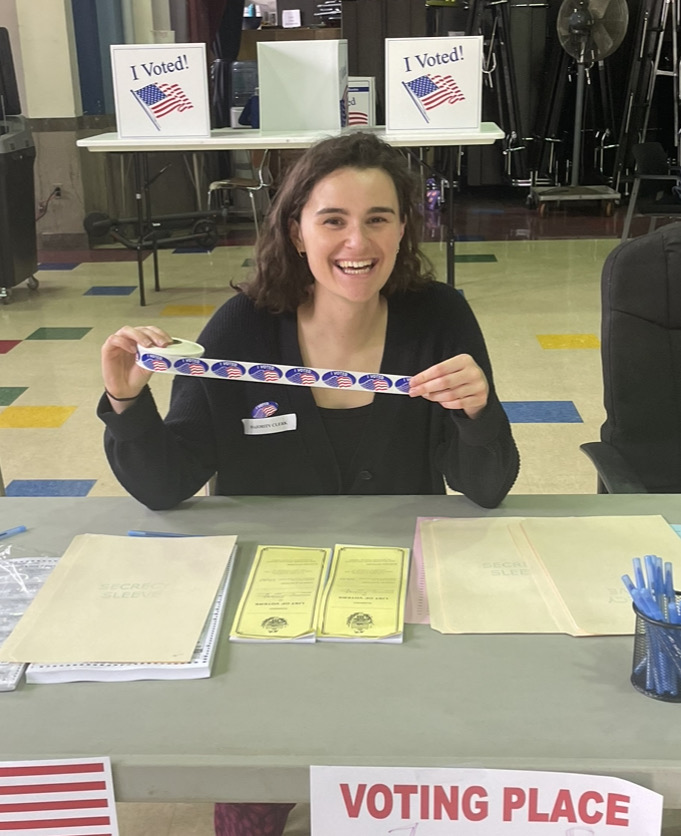Day in the Life of a Poll Worker
On May 16, 2023, I volunteered as a poll worker in my county for Pennsylvania’s municipal primary election. I recently joined my local League, and by poking around their website, I learned more about being a poll worker. Volunteering taught me more about everything poll workers do to keep our elections running smoothly and ensure that every voice is heard.
Signing Up & Training
I signed up on my county’s election website, which was shared in my local League’s newsletter. I filled out a form online and, a few weeks later, received a call from the election office to confirm some personal information, register for in-person training, and receive my polling place assignment.
Comprehensive training was offered for all new and returning election workers. While my training was in-person, the county had recorded trainings online.
Get involved in voter registration and outreach by joining your local League!
When I walked into my session on training day, our facilitator set up two different voting machines and a slideshow with printed instructions on how to operate the machines. For two hours, we ran through a typical Election Day — things to do when we first arrive, the rules and responsibilities of election workers, the differences between absentee, mail-in, and provisional ballots, and solutions to possible issues.
(Election) Day in the Life as a Poll Worker
The Morning
5am: Happy Election Day, Pennsylvania! The day before, I got a text message from my judge of elections, my point person and “boss” for the day, confirming I’d be at the polling place at 6am.
A typical workday for poll workers in Pennsylvania averages around 15 hours. Polls are open from 7am – 8pm, but workers need to get there about an hour before polls open to set everything up and stick around after polls close to go through closing procedures.
I made some coffee, ate breakfast, and grabbed a bag of essentials (phone charger, water bottle, snacks). My assigned polling place was just a few minutes away from my apartment, so I could walk over.
6am: I met the judge of elections and other folks on my team. Our polling place was in a school cafeteria, and we shared the space with another precinct. After dropping my things and filling out paperwork, I grabbed tables and chairs to set up. Some experienced election workers brought seat cushions and set up a food table with coffee and treats in the back of the cafeteria.
6:30am: By now, my team and I had taken our oaths and started to set up our space. We split into two teams: one to manage paperwork and the other to set up equipment. I was assigned to the equipment team, working with another election worker to set up the voting machines, privacy screens, and tables. We were given a comprehensive manual that outlined step-by-step instructions on how the space needed to be set up and how to turn on voting equipment properly. My team and I also reviewed what we could expect throughout the day.

7am: Polls in Pennsylvania opened. I sat at the check-in table with my first job: placing ballots into the secrecy screen.
Check-in operates kind of like an assembly line. The voter walks in, and one election worker asks for their name, checking the poll book to make sure the voter is in the right place and that they can vote today. Pennsylvania is one of the nine states with closed primaries, so only registered Democrats and Republicans can vote in primaries unless there are ballot referendums or local initiatives or if it’s a special election. Once the voter signs the poll book, another election worker ensures the voter gets their proper ballot.
Once the voter has been checked in, they receive a paper ballot in a secrecy sleeve from a third election worker and go to a table to fill it out. Once the voter makes their selections (filling in the bubble completely, with no marks outside!), they scan the ballot into a machine and cast their vote. If there are enough election workers on site, someone may be stationed in the voting area to ensure things are running smoothly.
Paper ballots were the preferred voting method for most voters at our polling place. However, to accommodate all voters, every polling place in Pennsylvania “must have at least one accessible voting system.” We had a separate voting machine that allowed voters to make selections on a touchscreen. Voters using this system insert a blank card into the machine, pull up their ballot type, and make their selections. Once the voter has filled out their ballot, the card is printed out, and voters cast it into the machine.
8am: An hour in, we’d had some voters stop by. When things slowed down, I got to know my team members better.
Pennsylvania voters had some major races on their ballots this spring: statewide, voters weighed in on candidates for state Supreme Court and appellate courts. There were several candidates on the ballot for mayor in Philadelphia, and Allegheny County had a crowded Democratic primary for county executive. A special election in Delaware County determined the balance of power in the Pennsylvania House, bringing in national endorsements.
Despite these important local races, voter turnout in Pennsylvania was relatively low, and my polling place had voters trickling in. However, many voters did vote-by-mail or complete an absentee ballot.
10:30am: Our first bit of drama! A Tesla across the street got towed. All the poll workers got up to watch this unfold live. Pro-tip: don’t block alleyways.
The Afternoon
12pm: More voters! We had a lunch rush.
Throughout the day, officials from the county election office checked in to see how things were going. They checked our polling place setup and asked if we had any issues. Some voters were at the wrong polling place. Some voters requested and received a mail-in ballot but decided to vote in person, which meant they had to surrender their mail-in ballot and envelope to their polling place to be voided. Fortunately, my polling place didn’t run into any major issues.
1pm: A fellow poll worker went to grab us lunch. I used this time to take my break, eat, grab some more coffee, and stretch my legs.
If poll workers have not already voted, they can use their break to go to their polling place and cast their ballot. While my polling place was within walking distance, I made my voting plan and voted by mail.
Support our work promoting free and fair elections.
2pm: One of my favorite parts of the day was learning about all the different election worker responsibilities. While I was assigned to the equipment team in the morning, I also had the opportunity to provide support at check-in by finding voters in the poll book, ensuring voters got the correct ballot, and giving out “I Voted” stickers.
3pm: Nine hours in, just a few more to go!
4pm: I’m starting to feel that early morning wake-up. When things were slow, my team and I talked about how you can become a judge of elections, Twilight, Peloton, and a voice-changing toy I bought to send my family fun voice memos.
The Evening
5pm – 7:59pm: More voters came in throughout the evening. We had another mini rush around 5:30pm since the workday was over.
8pm: Polls have officially closed in Pennsylvania, so it’s time to start our closing procedures. The step-by-step instructions I used in the morning also outlined closing procedures to ensure that ballots and other voting materials were secured safely, voting equipment was properly shut down and stored, and tables and chairs were put away.
8:45pm: My team and I completed all our closing procedures and said our goodbyes. On my way home, I grabbed some ice cream to celebrate a smooth Election Day!
I loved the opportunity to empower voters in my community by serving as a poll worker! Everyone I worked with was dedicated to making sure voters could cast their ballot, and make their voices heard. Reach out to your local League to learn more about how you can get involved as an election worker in your community.
The Latest from the League
There are many different roles election workers can play, from ensuring that polling places are accessible for those with disabilities to counting ballots to running a polling site.
To learn more, we interviewed Pinny Sheoran, president-elect of the League of Women Voters of Arizona, Isabel Longoria, former League of Women Voters of Texas Board member and current Harris County elections administrator, and Debra Cronmiller, executive director of the League of Women Voters of Wisconsin, both of whom have extensive experience as election workers.
It's up to us to make sure everyone has the information and ability to cast their vote!
Here are five ways you can empower voters and defend democracy through volunteer work.
With three months to go until Election Day, America is facing a critical shortage of poll workers, all of whom need to be signed up and trained in time for November.
Sign Up For Email
Keep up with the League. Receive emails to your inbox!
Donate to support our work
to empower voters and defend democracy.





